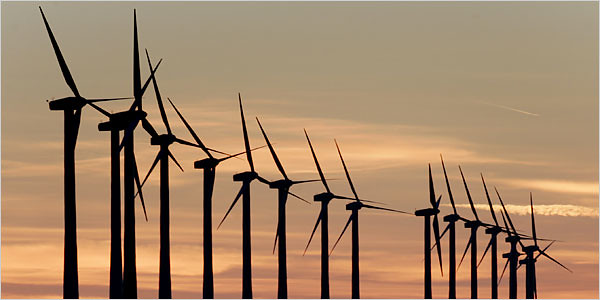Guide to Developing a Wind Farm
Article by James Mardian of Environmental News Online

Wind farms don’t go up overnight. With an average development cost ranging between $1.8 and $2.2 million dollars per megawatt, projects are never taken lightly. Years of careful planning, research, negotiation and approvals go into getting a wind farm off the ground – and that’s often just to locate and secure viable land. In fact, land procurement (and its related considerations) is typically the most arduous part of wind farm development, and it’s always the first step in the process.
Step 1: Choosing a Site
In order to choose an appropriate wind farm site, you first must understand the wind resource generally in an area, then gather information to detail that resource. In areas that are believed to be suitable, arrangements are made with landowners to survey the wind resources there, and agree to possible future wind farm installation. What’s the average wind speed on the land? How much does it vary? Which way does it typically blow? Can enough power be generated at this site to make the project economically viable? Studies that answer these and other pertinent questions are conducted with meteorological instruments for 12 months or longer before any further steps in the process are taken.
Other factors that play into land site selection include:
• Access (can the site be easily reached for construction and maintenance?)
• Ownership (who owns the land and are they willing to lease it?)
• Proximity to market (are transmission lines close by or will interconnections have to be built?)
• Environmental impacts (what are the potential effects on local plants, animals and heritage resources?)
Step 2: Permitting and Public Consultation
Once a viable site has been identified, it’s time to line up the necessary approvals to
get the project started. Regulatory and government obstacles can be daunting –
they vary from province to province and county to county, and most are slow to
overcome. In addition to gaining municipal, provincial and federal approval, wind farm
developers must gain the acceptance and trust of local residents, striving to build a
positive relationship between themselves and the people who live near the site.
Step 3: Construction
Once the project has been given the green light by the government and public, equipment and machinery for the site is purchased. Turbine technology has made great strides in recent years, but choosing the right machine for the right site is key in making a wind farm successful. Certain machines are designed specifically to function more efficiently at lower wind speeds, while others work best under vigorous conditions, so it’s essential to know your machinery as well as you know the site. The construction process of a wind farm is fairly straightforward and expedient when compared to all the steps leading up to it. First, service roads are built and foundations for each turbine are prepared. Next, the turbines are shipped to the site and put together piece by piece by a qualified installation crew. Cabling and interconnection to the utility grid are also done at this stage, in addition to establishing the on-going procedures for overall operations and maintenance of the site.
Step 4: Commissioning the Wind Farm
At this point, development is complete and the wind farm is ready to start operating. The substation is energized, bringing electricity into the facility. A number of checks are done on the electrical cabling to ensure proper function. Once these checks are complete the turbines are commissioned. A number of further checks and tests are then run on each turbine to ensure they
all are ready to generate electricity.

